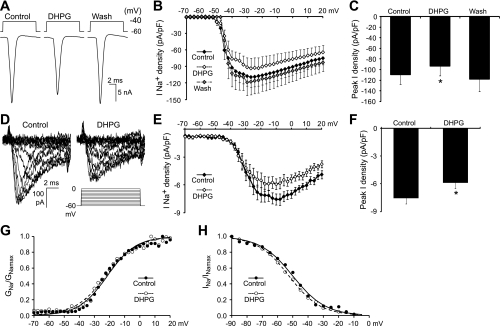Fig. 5.
Group I mGluR activation modulates the fast, inactivating Na+ current. A: fast, inactivating Na+ currents elicited in standard recording solutions by brief (10 ms) depolarizing voltage steps (−70 to +20 mV) in a motoneuron held at −60 mV in control conditions, in the presence of DHPG (50 μM), and after drug washout. Plots of current-voltage relationships (B) and average peak current density (C) for fast, inactivating Na+ currents demonstrate a DHPG-mediated reduction in Na+ current density (n = 11). D: Na+ currents recorded in control conditions and in the presence of DHPG (50 μM) in modified solutions designed to block Ca2+ channels, K+ channels, and synaptic transmission [TEA, 4-aminopyridine (4-AP), Cs+, CdCl2, bicuculline, strychnine, and kynurenic acid], and to reduce Na+ current magnitude by lowering the concentration of extracellular Na+ (10 mM). Plots of current-voltage relationships (E) and average peak current density (F) again demonstrate a DHPG-mediated reduction in Na+ current density (n = 6). Normalized activation and steady-state inactivation curves plotted in control conditions and in the presence of DHPG demonstrate no change in the voltage dependence of activation (G) or steady-state inactivation (H). *Significantly different from control.

